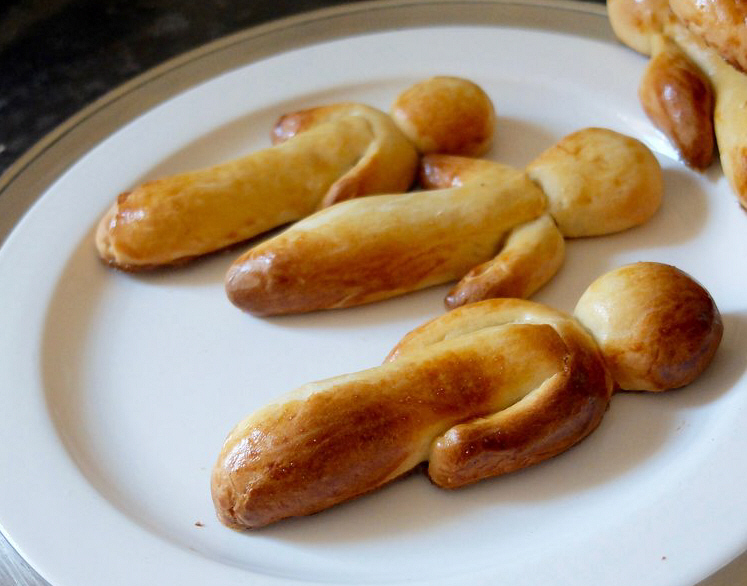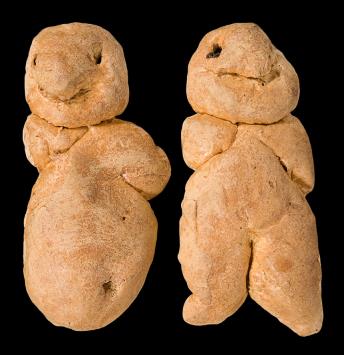

|
 (or 'Pop Ladies') Small sweet cakes flavoured with almond or rose water. Formerly made as human figures, possibly with fruit decorations for eyes, etc. A tradition associated with St. Albans, the origin is unknown, though they were in some way connected to a myth relating to St. Joan.  Pope Ladies Image: http://www.therecipeboxproject.com WB Gerish's 'Folk-lore of Hertfordshire' (1911) says that 'Pop-Ladies' were a tradition of New-Year's eve. 'British Popular Customs' by Rev TF Thiselton-Dyer, of 1900 has; "At St. Alban's certain buns called "Pope Ladies" are sold on Lady Day, their origin being attributed by some to the following story: - A noble lady and her attendants were travelling on the road to St. Alban's (the great North road passes through this town), when they were benighted and lost their way. Lights in the clock-tower at the top of the hill enabled them at length to reach the monastery in safety, and the lady in gratitude gave a sum of money to provide an annual distribution on Lady Day of cakes, in the shape of ladies, to the poor of the neighbourhood. As this bounty was distributed by the monks, the "Pope Ladies" probably thus acquired their name. Another correspondent ... says these buns are sold on the first day of each year, and that there is a tradition that they have some relation to the myth of Pope Joan."  Original Receipt from 'Feast-Day Cakes from Many Lands' by Dorothy Gladys Spicer (1960) reported in www.catholicculture.org Original Receipt from 'Feast-Day Cakes from Many Lands' by Dorothy Gladys Spicer (1960) reported in www.catholicculture.orgA few generations ago, "Popeladies! Popeladies!" was a familiar street cry on New Year's Day in the ancient Hertfordshire town of Saint Albans, where hucksters carried about baskets of curious-looking buns and bakeshops displayed them in windows. Pope ladies went out of fashion long ago. This is strange, too, since they taste much like hot cross buns. Their shape delights the fancy of children and arouses the curiosity of adults. The form of pope ladies is indeed extraordinary. Nobody knows how it originated. The dough is fashioned into the rude outlines of a female figure. A small round bun with currant eyes makes the head. The body, which has no legs and ends in a point, resembles nothing so much as an Egyptian mummy case. Two small lumps at the sides indicate arms. Today pope ladies are an amusing accompaniment to punch or hot spiced cider at the New Year's party. Drop-in guests on New Year's Day will appreciate them hot, with homemade preserves, and coffee or tea. Scald milk, add butter, sugar, and salt. Stir, and when cooled to lukewarm add yeast, which has first been thoroughly dissolved in the water. Sift together flour and nutmeg, and add gradually to the first mixture. Combine thoroughly. Add beaten eggs and mix together to make soft dough. Set to rise overnight in warm place, in a greased covered bowl. In the morning punch down the dough and shape into small buns that look something like this: Add currants for eyes, a tiny knob of dough for nose and two small strips for arms. Lay the buns about 3 inches apart in a greased pan and let rise in warm room. Brush over the top with mixture of egg yolk beaten with 1 tablespoon water. Bake about 20 minutes in moderately hot oven (350° F.) The following receipt, widely reproduced in recent cookbooks, with minor variations, is for a large, undecorated, Pope Lady Cake. It uses baking soda and cornflour, which would not have been available before the mid-19th Century.  The original source of this receipt isn't known. Can you help? editor@foodsofengland.co.uk The original source of this receipt isn't known. Can you help? editor@foodsofengland.co.ukPope Lady Cakes 8oz self raising flour 8oz caster sugar 1oz cornflour 8 egg whites 6oz butter 1/4 teaspoon almond extract Grease and line an 8” round, deep cake tin. Cream the butter and the sugar and 4 of the egg whites together. Add the almond extract and fold in the flour and cornflour. Beat the remaining egg whites till they are very still and gently but thoroughly fold into the cake mixture. Pour the mixture into the tin and bake in a pre-heated oven at 110°C/220°F/Gas mark 1/2 for 11/2 hours. Remove from the oven and cool on a wire rack.  Pope Ladies at the Pitt Rivers Museum, c1900 Image: http://objects.prm.ox.ac.uk/pages/PRMUID43873.html  |
|
MORE FROM Foods of England... Cookbooks ● Diary ● Index ● Magic Menu ● Random ● Really English? ● Timeline ● Donate ● English Service ● Food Map of England ● Lost Foods ● Accompaniments ● Biscuits ● Breads ● Cakes and Scones ● Cheeses ● Classic Meals ● Curry Dishes ● Dairy ● Drinks ● Egg Dishes ● Fish ● Fruit ● Fruits & Vegetables ● Game & Offal ● Meat & Meat Dishes ● Pastries and Pies ● Pot Meals ● Poultry ● Preserves & Jams ● Puddings & Sweets ● Sauces and Spicery ● Sausages ● Scones ● Soups ● Sweets and Toffee ● About ... ● Bookshop ● Email: editor@foodsofengland.co.uk COPYRIGHT and ALL RIGHTS RESERVED: © Glyn Hughes 2022 BUILT WITH WHIMBERRY |